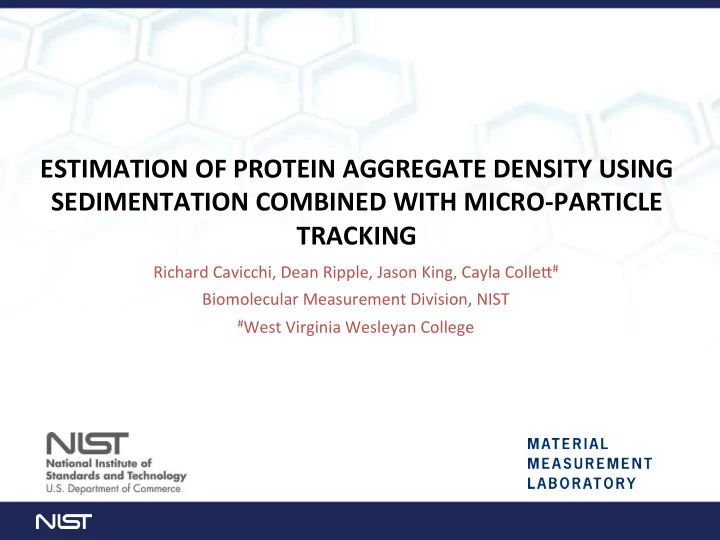

ESTIMATION OF PROTEIN AGGREGATE DENSITY USING SEDIMENTATION COMBINED WITH MICRO-PARTICLE TRACKING Richard Cavicchi, Dean Ripple, Jason King, Cayla Colle7 # Biomolecular Measurement Division, NIST # West Virginia Wesleyan College
Outline 1. Possible improvements to Flow Microscopy Analysis a. Shape effect b. New image processing algorithm 2. Aggregate Density measurements based on sedimentaMon 3. New Reference Materials a. Fluoropolymer aggregate simulants b. Other materials under development
Subvisible ParCcle Sizing Methods Light obscuraMon (LO) Δ I ~ area Flow Imaging (FI) area Electrical Sensing Zone (Coulter) (ESZ) Δ R ~ volume Resonance Mass Δ M ParMcle tracking D (related to d hydrodynamic )
Measured diameter, concentraCon for polystyrene beads. Good agreement
For Protein aggregates, methods don’t agree… Ripple, D. C. and Z. S. Hu (2016)PharmaceuMcal Research 33 (3): 653-672.
Protein aggregates vary in size, shape, intensity…
Variable Threshold Method for improved ParCcle Boundary DetecCon Can we get improved boundary detecMon without losing nearly transparent parMcles? New algorithm, break analysis into two parts: a) Find parMcles with a single low threshold b) Evaluate parMcle boundaries using a threshold appropriate to the intensity of each individual parMcle
Variable Threshold Method for improved ParCcle Boundary DetecCon Result: a b e c d
Strategy for fragments a. Connect fragments b. Draw the convex hull (a) c. and d. Perform “AND” operaMon with (b) (c) original thesholded area e. ResulMng boundary superimposed on image (d) (e)
Collage with overlays Results table of analyzed parCcles Implemented in ImageJ/FIJI, open source soeware
Collage strips of same beads analyzed with single threshold and Variable Threshold (red background) (Images obtained with Flowcam 10x) 2 µ m 5 µ m 10 µ m 10 µ m 20 µ m Test of Variable Threshold Method
10 µ m Variable Threshold SEM image ECD 13.4 µ m
Variable Threshold 10 µ m Test of Variable Threshold Method protein aggregates
Possible improvements to Flow Microscopy Analysis a. Shape effect, can use perimeter to improve equivalent circular diameter calculaMon for elongated parMcles. b. Image processing algorithm yields Mghter boundaries for intense parMcles, without losing counts on nearly transparent parMcles. i) be7er analysis for samples with varying parMcle properMes ii) same instrument seings for calibraMon and operaMon iii) may be useful for improved classificaMon of parMcles
What is the density of a protein aggregate and why is it important? M ρ = V Different methods characterize different aspects of size: Flow imaging: spaMal extent (A~V) Electrical Sensing Zone: liquid excluded volume (V’) Resonance Mass: M ParMcle Tracking: V h To compare parMcle counts above a certain size, or size distribuMon from these methods, a density value for protein aggregates is needed.
SedimentaCon/ParCcle tracking 9µ v µ viscoscity Measuring R from Δρ = For a sphere 2gR 2 v velocity image, and g 9.8 m/s 2 measuring v by following images, R hydrodynamic can deduce Δρ radius of sphere To reduce convecMon, use Rectangular glass capillary 50 µ m or 100 µ m inside thickness x 1 mm, sealed at both ends
Aggregates from NIST MaB 100 µ m
SedimentaCon: Stokes Law 9µ v Δρ = 2gR 2 Where µ is viscoscity, g is gravitaMon constant, v is the velocity (iniMal –final verMcal posiMon/Mme), and R is parMcle radius from image or Brownian trajectory analysis (below) Brownian MoCon- MicroparCcle Tracking Analysis <x 2 > = 2Dt D diffusion constant k B T D = For a sphere R hydrodynamic 6 π µ R radius of sphere <x 2 > is mean square displacement, calculated from parMcle trajectory (see D. Ernst & J. Kohler, Phys.Chem. Chem. Phys., 2013, 15, 845)
What is the density of a protein aggregate?
3 mm Polystyrene beads in water 100 µ m
3 mm Polystyrene beads in water, background subtracted 100 µ m
3 mm Polystyrene beads in water, with tracks ParMcles analyzed by custom ImageJ plugin Tracks determined using Trackmate 100 µ m
Bead trajectories - MicroparCcle tracking analysis 3 µ m 1 µ m 2 µ m 5 µ m 10 µ m Polystyrene beads in water
Results 1 µ m bead
Results 2 µ m bead
Results 5 µ m bead
Results 10 µ m bead
Beads: Image Diameter vs Tracking Diameter Beads: Density by MSD Image 1 54.2431 66.7852 MSD & Image(aaer 2 51.9681 69.5542 diam correcCon) 5 43.1026 41.0793 10 53.313 43.664
Beads: Image Diameter vs Tracking Diameter Beads: Density by MSD & Image MSD Image 1 54.2431 66.7852 2 51.9681 69.5542 5 43.1026 41.0793 10 53.313 43.664
Aggregates from NIST MaB with tracks 100 µ m ParMcles analyzed by custom ImageJ plugin Tracks determined using Trackmate
Density vs Tracking Diameter Average Avg density ~1040 kg/m 3 Aggregate density increases with decreasing size
Conclusions • Improvements in analysis can provide be7er accuracy in parMcle sizing for Flow imaging: variable threshold plugin for ImageJ/FIJI • ParMcle density criMcal for relaMng counts from different instruments • MicroparMcle tracking gives useful dimensions up to ~5 µ m • Results based on sedimentaMon of 1 µ m-7 µ m parMcles indicates a density of 1040 kg/m 3 , with density increasing with decreasing size. This density is lower than generally assumed in the literature.
Silica beads n=1.33 fluid 4 µ m 6 µ m 20 µ m Silica beads n=1.43 fluid 6 µ m 4 µ m Variable Threshold Test of Variable Threshold Method
Protein aggregate at different focal distances 5 µ m
Recommend
More recommend